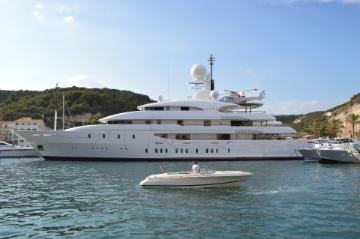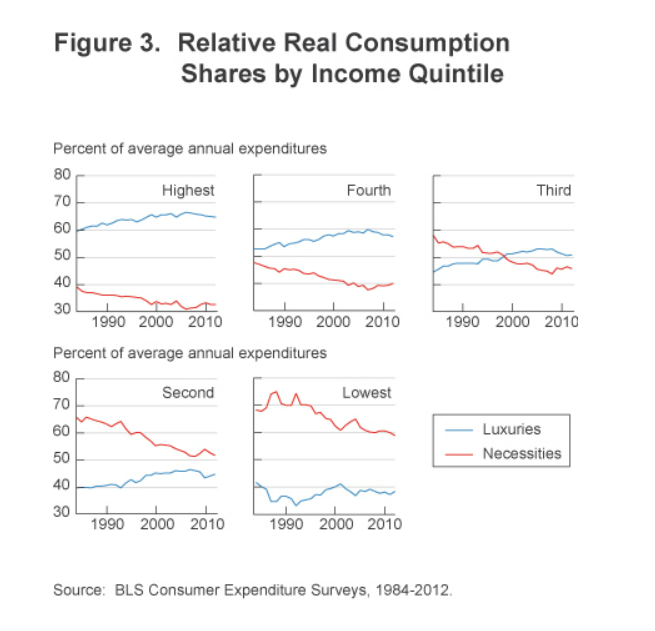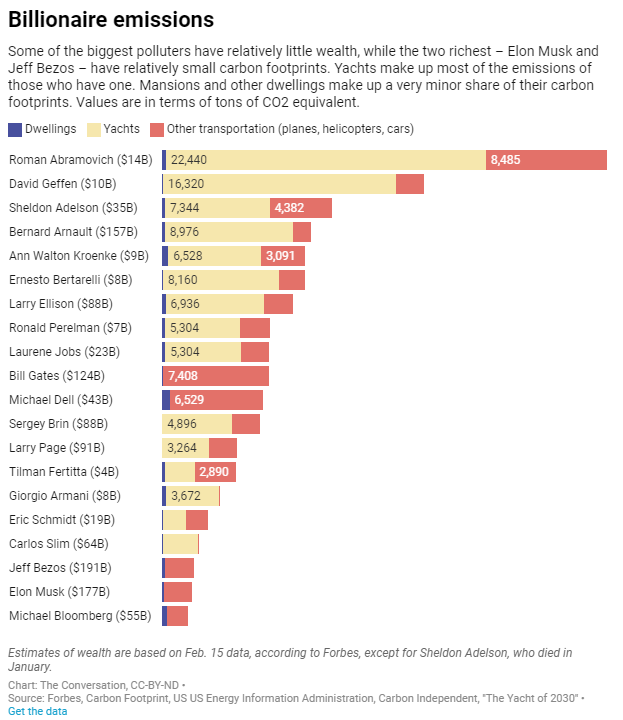
Ramon Duran, a 2021-22 Environmental Ethics Fellow, and Brian Green, director, technology ethics, both at the Markkula Center for Applied Ethics. Views are their own.
The Earth’s environment cannot sustain humankind’s level of consumption. However, not all people consume resources equally; resource consumption is highly dependent on access to resources, and particularly economic access: wealth. While the Earth could likely sustain the level of consumption of the non-wealthy of the Earth, it cannot sustain overconsumption by the wealthy. What qualifies as overconsumption may depend on a variety of context-specific variables such as geographic location, economic development, and access to technology, but there are some forms of consumption that are intrinsically excessive, no matter where one is in the world or their cultural or technological backgrounds. These intrinsically excessive forms of consumption can include conspicuous consumption for the sake of showing off, and highly resource-inefficient forms of consumption.
The purpose of this article is to show that ESG evaluation standards should expand beyond their present criteria to include the importance of overconsumption and give lower ratings to companies that promote overconsumption, especially of unnecessary goods. Because ESG is concerned with the development of market-based incentives and structures that prioritize sustainability, it becomes very important to consider exactly what is included in these criteria for sustainability. One consequence of this is that the socio-economic meaning and value of productivity is also thrown into question—because not all productivity is good or necessary. The inspiration for this renewed perspective on overconsumption is that the present global level of consumption places so much strain on the environment, climate, and non-renewable natural resources that long term economic growth is not feasible. Because of this, the most egregious forms of overconsumption ought to be strongly discouraged, and ESG investing is one way of doing that.
Wealth and Overconsumption
Research shows that “the world’s top 10% of income earners are responsible for 25 to 43% of environmental impact. In contrast, the world’s bottom 10% of income earners exert only around 3 to 5% of environmental impact.” [1] Clearly, there is a correlation between income and the extent to which an individual negatively impacts the environment. The top percentiles of income earners create environmental impact through their intensive consumption of goods and services; in other words: overconsumption. Examples of this overconsumption might include oversized vehicles, exceptionally large homes, frequent driving and flying or using private jets, frequent home renovations or tearing down and rebuilding homes, owning large boats or yachts, and excessive and continuous online and in-person retail purchasing of clothing, furniture, electronics, etc. Having greater amounts of discretionary income is evidently one factor that enables certain individuals to consume beyond their needs.

Comparison of consumption of luxuries vs. necessities by quintile [2]
Of note is that the over-use of resources is not just cost of the product or cost to maintain the product, but often in the mere existence of the product itself, which might be intrinsically unnecessary. For example, an expensive luxury car is just another form of car, and in some places cars are a necessity for getting around. But is it excessive? If the car is made from rare resources the extraction of which highly impacts the environment, it might be excessive. Or if the vehicle uses enormous amounts of gasoline, or frequently requires new tires (which then become waste), this also might be excessive consumption.
However, simply having one nice car pales in comparison to some of the excessive consumption by the richest people on Earth. In fact, the use of resources by the wealthiest quintiles and deciles is not nearly as excessive as the use of resources by the very extremely wealthy: billionaires. The chart below shows the carbon emissions of 20 billionaires. From the chart it is visible that their “megayachts” (yachts hundreds of feet in length) and other forms of transportation account for the vast majority of their carbon output [3]. Needless to say, megayachts and private jets are unnecessary luxury goods, and might be the very epitome of conspicuous, excessive, unnecessary, overconsumption.

These paragon products of overconsumption are made by companies, which means that these companies themselves generate products that are not necessary: they are wasting resources. Corporations that produce megayachts and private jets, then, would be two examples of production which inefficiently overconsumes natural resources. While several of the companies that produce megayachts are privately held (such as Feadship, Lurssen, Nobiskrug, Oceanco, and SilverYachts), and thus not typically included in ESG ratings, companies that produce private jets, like Gulfstream and Bombardier, are either publicly traded or are parts of publicly traded corporations, in Gulfstream’s case General Dynamics [4]. ESG ratings agencies should therefore take note: these corporations are producing products that can be intrinsically opposed to the “E” component of ESG.
Importantly, transportation needs are real and people do need to get from place to place. The ethical fault in megayachts and private jets lie in their inefficiency. While megayachts might serve as transportation they are more typically for entertainment purposes and therefore should probably be classified as among the least resource efficient forms of entertainment that humans have ever devised. Private jets likewise burn immense amounts of fuel to move only a few people around. Compared to commercial aviation, private jets may be convenient, but they are terrible for their environmental impact per passenger-mile. Economy class on a commercial airliner produces a lot of carbon dioxide emissions; a private jet is orders of magnitude worse [5]. If these products were less common or did not exist, the environment, and the world, would be better off. Companies that make these products, then, ought to get worse ESG ratings. And merely creating “greener” megayachts and private jets will not solve the problem: these products are intrinsically wasteful, they waste resources by their very existence, not only in their use. Companies that produce these products should find new business models.
There are also other companies that produce luxury goods that nobody really needs, and ESG ratings agencies should consider carefully what products and corporations might fall into this category. When ESG ratings agencies find these products and companies, they ought to be rated negatively for their waste of resources which are harming the future of humanity and the environment. If the ESG movement is to ever be truly credible, then overconsumption must become a factor in rating corporations.
References:
[1] Wiedmann, T., Lenzen, M., Keyßer, L.T. et al. “Scientists’ warning on affluence.” Nature Communications 11, 3107 (2020). https://doi.org/10.1038/s41467-020-16941-y specific quote: https://www.nature.com/articles/s41467-020-16941-y#:~:text=These%20values%20mean%20that%20the,5%25%20of%20environmental%20impact35, citing Teixidó-Figueras, J. et al. “International inequality of environmental pressures: decomposition and comparative analysis.” Ecological Indicators 62, 163–173 (2016).
https://www.sciencedirect.com/science/article/abs/pii/S1470160X15006731
[2] LaVaughn M. Henry “Income Inequality and Income-Class Consumption Patterns,” Economic Commentary (The Federal Reserve Bank of Cleveland), October 6, 2014.
[3] Richard Wilk, Beatriz Barros “Private planes, mansions and superyachts: What gives billionaires like Musk and Abramovich such a massive carbon footprint.” The Conversation, February 16, 2021. https://theconversation.com/private-planes-mansions-and-superyachts-what-gives-billionaires-like-musk-and-abramovich-such-a-massive-carbon-footprint-152514
[4] Antonia Maria Markou “World’s Best Luxury Superyacht Builders, 2020,” Ceoworld Magazine, March 9, 2020. https://ceoworld.biz/2020/03/09/worlds-best-luxury-superyacht-builders-2020/
[5] “COP26: What’s the climate impact of private jets?” BBC News, November 2, 2021.
https://www.bbc.com/news/59135899
